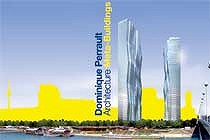
|
Dominique Perrault Architecture Meta-Buildings PRESS RELEASE The Az W is delighted to present a major show about this French star architect. In 1989, at the age of only 36, Perrault won one of the most important French architecture competitions: with his Bibliothèque Nationale de France in Paris, completed in 1995 as one of the “Grands Travaux” from the era of François Mitterrand, he achieved his international breakthrough. Today Dominique Perrault can be viewed as representative of an entire league of important architects who, as one of the consequences of globalisation, design exciting buildings throughout the world irrespective of their individual nationalities. Perrault has also made important contributions to contemporary architecture in Austria: he was instrumental in designing the Town Hall in Innsbruck as well as three MPreis supermarkets in Wattens and Zirl. Vienna DC Tower 1 and 2 in Vienna, currently at the planning stage, is an urban expansion project at the highest international level and provided the occasion for the Architekturzentrum Wien to place Perrault’s work in a broader context. In addition to presenting four projects currently at the planning or construction stage designed by Dominique Perrault Architecture for four different locations, this one-man show developed especially for the Az W focuses on the question what contribution – apart from the classic functional or economic aspects – major projects of this kind can make to a city that finds itself in a state of change. THE PROJECTS IN THE EXHIBITION EWHA Womans University Campus Center in Seoul (2004–2007): a campus center for 20,000 women students containing academic, commercial and administrative functions. The six-storey university building is “buried” in the surrounding park: the site opens up along a length of 200 metres, it is only on accessing this sloping slice through the topography that the two-part building reveals itself. Mariinsky II Theater in St. Petersburg (2003-2009): This extension to the old Mariinsky Theater that was built in the historic centre of St. Petersburg in 1860 contains an auditorium with 2000 seats for opera and ballet performances as well as concerts, a public foyer, exhibition spaces, restaurants and shops. The dominant enclosing shell, deliberately set at a certain distance apart from the theatre building itself, creates exciting interstitial spaces and additional public urban areas. Vienna DC Tower 1 and 2, Vienna, since 2004: Two towers (220 and 160 metres high) containing mixed uses (offices, hotel, residential etc.) are intended to form a striking urban gateway for the Donau City in Vienna. The project includes a terraced area that will provide a connection to the river and the Reichsbrücke. The two towers are placed on the planned terraces: like the shifted parts of a fragmented block, between them they define a new public space. Olympic Tennis Stadium in Madrid (2002–2008): a multi-functional building on the periphery of the city, interpreted by Perrault as an infrastructure for the landscape of the surrounding Manzanares Park. The roofs above the three arenas can be opened like lids; the facades of the building are made of a metal mesh that is permeable to air so that the outdoor space of the park is atmospherically continued in the interior of the building. META-BUILDINGS ‘A meta-building is one that exceeds the dimensions of normal buildings, in terms of both scale and concept, to the benefit of its surroundings. A meta-building transforms a place into something different, impregnating, organising and working together with the surrounding space. A meta-building is not merely a building but forms part of the urban fabric, no longer using its context as a reference but as a material.’ (Dominique Perrault) In each of the four projects presented in the exhibition Perrault does not design just an isolated building but also an additional, functionally flexible area that can be actively appropriated by the public. This kind of additional space transforms the building into a meta-building that enables us to experience architecture as a part of the city and the city as a continuation of architecture. Thanks to its size the meta-building is lastingly inscribed in the urban spatial concept; conversely urban public space is continued in the interior of the building. Perrrault has described this symbiotic understanding of the city and buildings as an ‘architecture of disappearance’, an architecture that plays down the classic aspect of representation in order to all the more dramatically surprise the user with unusual presentations of space. THE EXHIBITION The exhibition in the Old Hall of the Architekturzentrum Wien shows in a central position four current projects in which the architect’s intentions are concentrated. The projects are presented by means of videos, photographs, plans and drawings of different design phases, most of which are being shown for the first time. Four large models that were specially made for the Az W presentation illustrate the spatial relationship of the buildings to their surroundings. In addition an intervention by Perrault will extend the exhibition into the Museumsquartier site: a spatial installation in the courtyard in front of the Az W exhibition hall manifests Perrault's connection to Austria by showing the three MPreis markets in Wattens and Zirl, as well as the Town Hall in Innsbruck that was opened in 2002 (photographs by Jordi Bernadó). A catalogue will appear in conjunction with the exhibition (authors: Ilka and Andreas Ruby, edited by: Architekturzentrum Wien) CREDITS Exhibition concept : Dominique Perrault Architecture, Gaëlle Lauriot-Prévost, Ségolène Pérennès-Poncet Collaborators: Tomoko Karakawa Project coordination: Gudrun Hausegger Exhibition graphics: Gabriele Lenz, Cyril Lancelin With the kind support of the French Cultural Institute Vienna. |
 |
|
© Perrault Projets |
|
Press page Current events Past events Gallery: Images for the press: Dominique Perrault Architecture Dates: Dominique Perrault Architecture Downloads: Pressrelease Dominique Perrault Architecture Information: Ines Purtauf Tel.: +43 (1) 522 31 15 - 25 Fax: +43 (1) 522 31 17 Email: purtauf@azw.at |
| © Architekturzentrum Wien 2025 |
||



